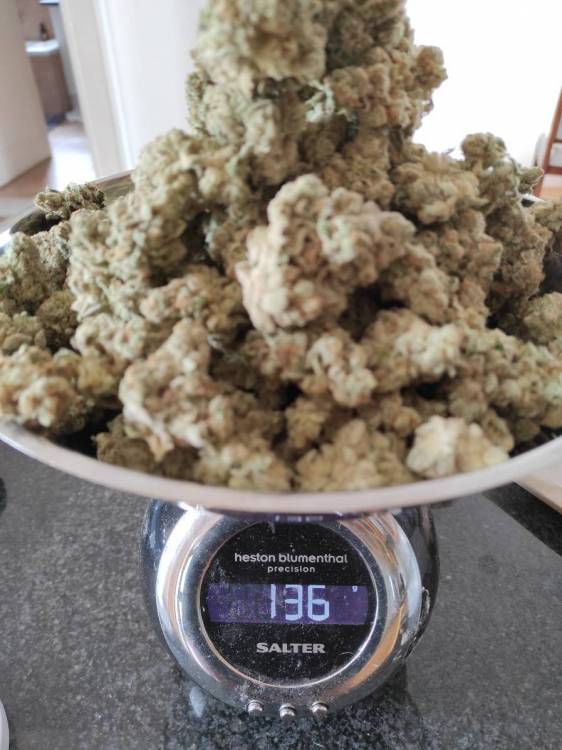-
Posts
3,487 -
Joined
-
Last visited
-
Days Won
125
Content Type
Profiles
Forums
Calendar
Gallery
Articles
420 Directory
Classifieds
Posts posted by PsyCLown
-
-
... Still waiting.

Sent from my Redmi Note 7 Pro using Tapatalk-
 2
2
-
-
Your grow is looking great! Nicely scrogged, plants are looking happy, defoliated nicely.
Super excited to see how the harvest turns out!
Sent from my Redmi Note 7 Pro using Tapatalk-
 2
2
-
 1
1
-
-
That's pretty cool, I tried the Haifa nutes but moved away from them.
@CreX still uses them I believe.
Sent from my Redmi Note 7 Pro using Tapatalk-
 3
3
-
-
Dear Psyclown,
Thankyou so much!. 10 out of 10 for that answer!.
I feel fully clued up know.
Trouble is.......I do get a bit carried away at times. I lived in Spain for a few years and had absolutely no electricity up in the hills. My solar system worked like a dream. I only grew outside, so didn't need too much power. However, the system handled a pool pump for 7 hrs every day , the household water had pumps also.
That was 5 years ago. Wow .......solar has moved on from then!.
Anyhow, turns out I'll need a lot more power than my old 6 panel system! (Photo).
At least now I know what I'm dealing with and what I need to make things work.
I'm going ahead with my intended system in the knowledge that I can add extra panels and battery later.
I've come to peace with the fact that it will cost me a lot more than I had previously thought!. Just have to wait to get the funds together that's all. Patience is the key.
One other thought; What if I scaled it right down to single tent with one plant?. One reasonable plant?. But then I suppose you still have to have the same gear, fans etc.
Ah well, my dream of giving Eskom the finger alludes me for now .
.
Thanks again for your valuable insight.
Have a lekker weekend. PS, Photos will be sent separately as they are on my pc.
So regarding 6 panels and adding more later, remember that the string of panels ideally needs to be in a certain voltage range - too low and efficiency drops, too high and it'll cause permanent damage to the inverter.
If the amps (current) is too high per string / mppt the. That'll just get cut and limited.
Also remember you need to take into account the temperatures as that'll affect the voltage, cold weather will lead to higher voltage. So you need to work it out to be in a safe zone.
As for going down to a small tent of say 80x80
Putting a small light of no more than 240w inside, will definitely reduce the power required. Smaller tent, means less lights and smaller fans and therefore less power.
If running the light at max during flower, fans may come to approx 60w so call it 300w in total at max.
In veg it'll be less power and you could get away with just an extraction fan and one fan inside for air circulation.
Sent from my Redmi Note 7 Pro using Tapatalk
-
 1
1
-
-
A bit of a TLDR, so did not read every post but will try answer all questions.
I have looked into a solar setup myself and have had friends who have gone ahead with solar setups - if you use a lot of power it makes sense to go this route.
Firstly, 5KW inverter with 2.2KW of panels is silly, you generally want to try and aim for more panels than the inverter is rated for as the panels efficiency will decrease with time and are the limiting factor as to how much power you can pull from the sun. The weather varies, some days there will be more cloud coverage and power production starts when the sun rises but you won't be generating max power early in the morning or late in the afternoon when the sun starts to set - this is where the additional panels will start to shine and help you maximize how much power you are able to produce throughout the light cycle of the day - as you seem to be aware, winter things change as well and there are less hours of light.
So without a doubt, look at adding more panels. Especially if you want to run the whole house and subsidise the grow when the sun is shining.
Also make sure that 5KW is sufficient for your house, draw too much and the inverter will trip - your whole house is then without power until you turn it on again. Geyser, kettle, stove, grow lights, fans, aircon, dishwasher, washing machine, tumble dryer TV etc. etc. It can all add up quickly
You may need to change your habits in terms of how you use electricity and what appliances you have on at the same time in order to make the 5KW inverter work. This is something only you'd be able to work out as you know what appliances you use and when you use them.
Now onto the question of your grow equipment and the draw and the battery.
Let's start with the grow equipment, for a 1.2m x 2.4m tent you'd like to aim for 4x 240W Quantum Boards which comes to just under 1KW of power (let's round up to 1KW take the efficiency of the driver into account).
You will need to have fans to circulate the air, as well as for extraction and possibly intake as well. 100W to 200W is a reasonable estimation, we'll go with 200W to be on the safe side.
Now depending on your grow, there may be additional equipment such as water pumps for automatic watering (often not a high amount of power), aircon, dehumidifier - these need to be taken into account if you are running them.
However we can consider a base load of 1.2KW when your tent is running at full power with all fans. So that means 1.2KW (1200W) which is being drawn by your tent per hour. 1.2KWH in other words or 1.2 units per hour. During veg you can dim the lights down to around 400w in the tent and should be fine, in flower you will be pushing the full 1KW of power to the lights if you have the tent full of plants.
So for veg, 600W per hour with fans.
For flower, 1200W per hour with fans.
When lights are off, 200W per hour for just the fans.
Lithium battery is 100% the way you want to go, they generally come with a 10 year+ warranty and are able to be discharged more than your typical gel / deep cycle batteries. What is meant by discharge (also known as depth of discharge), well, the 5KW battery is basically a 105ah battery at 48v (105ah x 48v = 5040W (5KW) ). We can use the 5000W figure here to explain DoD (Depth of Discharge):
A 10% DoD means the battery has been drained by 10%. So 5000 - 10% = 4500W of charge remaining in the battery. 50% DoD = 2500W remaining in the battery. 80% DoD = 1000W of power remaining in the battery.
Your typical AGM / deep cycle batteries can be discharged to around 50% at most and even then they have far fewer cycles which they can handle (a decent deep cycle AGM type battery can handle around 600 cycles).
A Lithium battery can be discharged past 50% safely, unlike your AGM / gel / deep cycle type of batteries which can take serious, permanent damage if discharged past 50%. Most Lithium batteries for solar use are able to be safely discharged to anywhere from 85% to 100% - keeping in mind that the further you discharge it, the fewer cycles you will get.
As an example, a Lithium battery may be good for 6000 cycles at 80% DoD but only 3500 cycles at 100% DoD. These are rather accurate figures for Lithium batteries as well, I think Hubble and/or Pylontech batteries offer figures similar to the above. As you can see, 6000 cycles is 10 times more usage out of the Lithium battery compared to an AGM style battery with 600 cycles. Also you are able to get 80% discharge out of the Lithium battery (4000W) compared to 50% discharge out of the AGM battery (2500W).
Another figure to briefly touch on is the constant discharge rate, not all batteries are able to safely provide the required current for an extended period of time. So you may require multiple AGM batteries in order to safely allow the 5KW inverter to draw 5KW of power from the batteries.
You get Lithium batteries where a single battery is able to provide sufficient power to max out a 5KW inverter - one thing to keep in mind when looking at buying batteries for your inverter (or a single battery).
So now to the final part of your question, how long will the battery be able to run your grow setup for. Well, I have done the basic maths already so we know that with lights during veg you are drawing 600W of power roughly (per hour) and the battery has a total capacity of 5000W (let's say you want to only discharge to 80% to help prolong battery life, or to keep some power spare incase of load shedding / emergencies). That leaves us with 4000W of power to draw from the battery.
4000W / 600W = 6.66 hours (Around 6 hours and 38 minutes I think)
In flower, a very different story. Literally half as the draw is 1200W.
4000W / 1200W = 3.33 hours (Around 3 hours and 23 minutes I think)
The above calculations do not take into account whatever else is running and drawing power in the house. If your geyser turns on and it is a 3KW geyser, that is 3000W it can use within an hour and will almost drain the battery quickly, almost to the full 80% DoD within an hour.
Fridges & freezers cycles on and off multiple times throughout the day, there will often be basics running such as the fridge / freezer, some lights, router for internet etc. These are often small amounts of power being drawn but it is still there and needs to be taken into consideration.
The biggest benefit with solar is being able to run off the panels during the day when the sun is shining and this is where the biggest cost savings will come in. The battery is nice to have, but running a grow off batteries for an extended period of time is stupidly expensive for initial costs (around R25k for a 100ah Lithium battery). When the sun goes down, it makes more sense to switch over to Eskom's grid and keep the battery for load shedding or emergency use and during the day when there is a bit of cloud coverage.
If you need to be off grid, the cheaper way would be to have a generator tied to the inverter as opposed to buying multiple batteries. However when it comes to running costs - over a long enough period of time the generator may work out more expensive and it has it's drawbacks too - requires fuel, isn't good for the environment with the emissions, require services & maintenance and it is noisy. However the initial cost of a generator is far cheaper than multiple batteries.
-
 1
1
-
 1
1
-
-
13 hours ago, Dookie69 said:
Great debate guys, some interesting takes on the subject.
I grow Auto’s in Autopots. All the plants (between 2 and 9 depending) get the same feed because of the common reservoir. This can be tricky when I have a mixture of Auto’s which I usually do (3 of the same seeds 3 times = 9 per grow).
A harvest for me takes over a week. I have limited time with my grow so can’t get it done faster. So I have to keep feeding because it might be 8 or 9 days from first to last. Not as bad as it sounds since some mature faster, they come down first.
I sometimes do partial harvests meaning I remove all the top bud and will leave the smaller, larf / popcorn for another week to get good light.
Anyway to cut to the chase, it’s out of necessity rather than preference that I no longer attempt a final flush (I mean an only-water for 1 or 2 weeks flush).
Instead I feed with TA Final Part, which is a ripening agent devoid of any Nitrogen. There is mention above that the plant suddenly start drinking less, much less, towards the end. This is very obvious in the Autopot res which isn’t drain to waste, so the plants only pull what they need. And since they are consuming much less, they naturally “starve” themselves as I assume they do in nature. It follows on then that even if I have a high concentration of nutes (5ml per litre), the fact that LESS of it is going into the plant must equate to a lowering of Nute strength over time. This then might suggest that perhaps those who hand water might inadvertently be over feeding plants in their later stage of life.
Anyway, I have discovered that the whole smooth vs harsh thing boils down to your drying process, and the taste boils down to your curing process.
I got paranoid I was over drying and cut it a bit short. Some of that bud was harsh. The (almost over dried) bud from the next harvest was silky smooth, burned white ash in spite of having no flush, no period of darkness. They did however have lower temps towards the end.
There is a school of thought now that flushing may improve taste, not because of leaching out excess nutes, but because of the shock presented to the plant which can trigger more terpene production….There are better ways to trigger an immune response and I feel you'd want that immune response earlier in flower... Perhaps even in veg.
More research likely needs to be done on this for cannabis for us to really know though.
Plants certainly start drinking less as they are reaching their end of life. Nutes can also build up in your medium over time, especially if one does not reduce / taper the nute strength towards the end of flower and this can lead to plants being burnt a bit.
-
 4
4
-
-
Doesn't seem many seedbanks stock Bodhi seeds anymore, at least not locally.
Sent from my Redmi Note 7 Pro using Tapatalk-
 2
2
-
-
1 hour ago, Ill_Evan said:
So 136g dry from 6 plants, where quite a bit was tossed due to bud rot?
The plants had no training either, so single cola only?
-
 1
1
-
-
2 hours ago, Ill_Evan said:
Fun fact, if you run a commercial cannabis farm in Australia, nobody in the entire company, including the janitors or even cultivators, are allowed to consume any cannabis whatsoever.
Such a nanny state.
Did you know that if you hoon your car, they will impound it and destroy it. Super strict on certain things, unnecessarily so I feel.
-
 2
2
-
-
You don't need to smoke in order to be able to grow.
However not smoking / sampling your own plants can leave you a bit in the dark when it comes to how smooth the smoke it, taste, effects, potency - this can easily be resolved by sending the bud in to be tested and/or having someone who can assist and sample for you and give you feedback.
I have grown a few autoflowers, I can tell you first hand that the potency has always been lower with the autoflowers compared to the photoperiods I have grown. Had I not sampled them myself, I wouldn't have known.
With that being said, I know of people who grow but do not smoke themselves... They get by fine as others sample for them or they grown clones of known plants which others grow.
-
 2
2
-
 1
1
-
-
Dirty Banana and Beach Wedding both look pretty decent, how is the bud size though? Does yield look as if it may be good?
Sometimes a bit hard to judge off a single photo.-
 2
2
-
-
-
I got a really really awesome one from The High Co @THCSA I am sure you have seen them sponsor quite a few comps on the forum as well.
There might even be more options available which are not loaded on the website, reach out to them. You won't be disappointed.
I would suggest getting a rig where the banger sits flat and not at an angle (so a straight stem).
-
 4
4
-
 1
1
-
 1
1
-
 1
1
-
-
3 hours ago, Weskush said:
Yo @Naughty.Psychonaut . I ordered myself a PF Tek innoculation kit, PF Classic spore syringe and some perlite from B&B. You reckon that i can use my propagator for fruiting? It has holes in the bottom and an air vent on the lid. This will be small scale and my first time trying psilocyben shroom cultivation. Shot

You could, otherwise just build yourself a shotgun fruiting chamber and fill it with some perlite.
Also keep in mind trichoderma is a very aggressive fungi which will be to your detriments when you're trying to grow mushrooms. If you have ever used products which contain trichoderma (rather common with cannabis products), the chances of contamination are much higher.
I am not a big fan of PF Tek, it works but there are better ways out there. Do it for your first grow then move away, rather try trays.
-
 2
2
-
-
On 1/25/2022 at 7:45 AM, Naughty.Psychonaut said:
with living soil you also don't need to feed nutes to the plant all the time, only when the plant is hungry, most of the time you're giving clean water. the plant itself, when it comes to the end of its cycle it will naturally take in less and less of certain compounds. if you're still giving nutes at that time, again you're wasting and you're force feeding the plant and it'll probably just go through to the next season. when the plant is finished creating buds for it's 8-16 week flower period, it won't put on more weight it wont get stronger it wont get less harsh (don't know how that's even a point in this argument) it wont do anything for you, except waste your time and money. again.
You pretty much hit the nail on the head with this statement. The plant will only take what it needs, giving the plant access to more nutes does not mean it will use them.
So whether the plant is sitting in soil or hydro, it will only use the nutes it needs when it needs them.
As for why continue feeding the plants in the last 2 weeks or so of flower as opposed to giving them plain water... Well for one the medium you are growing in plays a big role, in soil this is fine as the soil still contains nutrients.
In hydro or coco, different story. Put plain tap water through coco or refill a hydro res with plain tap water and you have a ppm of like 79 and a PH which is waaay too high for the plants.
The plants want to try maintain a balance as well in terms of the ppm / EC (solute concentrates - think nutes), so taking a plant from a higher EC environment of say 1.6EC and moving it into a res with an EC of basically 0.0EC will lead to the plant being unhappy and trying to balance the concentrate within the plant / root zone and the medium it is in.
I feel this will be detrimental to the plant. The correct way to go about this would be to gradually reduce the nutrient strength towards the end of flower or look at adding other things into the feed to obtain a similar PPM / EC to prevent such an extreme balancing.
The info you posted states that if anything, the results from a 0 day flush was preferable (smoother & better taste) but ultimately the difference is soo negligible that it does not really matter. So for someone growing in coco or hydro, it is easier to continue to feed the plants with nutes to avoid issues and ensure the PH remains in the right range.
For someone growing with soil, especially if you are not feeding nutes often... go for it and feed water. Don't call it a flush though. You're just not feeding nutes. Osmosis can still occur in soil, if you are feeding nutes and the EC builds up in the soil.
Is it necessary to do this? No, I do not feel it is and the research done by RX Green Technologies also points towards little to no benefit either way.
-
 7
7
-
-
-
There is also this, quite a bit cheaper: http://www.tasniavape.co.za/Exseed -Dabcool-W2-Dab-Rig-Kit
Never used any of these devices though.
-
I took a look a while back for myself, but, came to the conclusion that something decent is likely not going to be all that cheap and my dry herb vape is sufficient. I have a glass dab rig for when I want to hit a dab.
This one looks really nice: https://www.vaperite.co.za/product/puffco-peak-pro-vaporizer/
Also the Dr Dabber ones both look good:
https://vapestore.co.za/table-top-vaporizers/dr-dabber-switch-vaporizer
https://vapestore.co.za/portable-vaporizers/dr-dabber-boost-evo
Then there is also this Oura: https://vapestore.co.za/portable-vaporizers/kandypens-oura
However prices on all of them are a bit steep.
-
85g dry for a plant in a 10L plastic pot is not terrible either though (No 12).
Will await the final smoke report, although am keen to get a cut of No 12 when possible

-
 2
2
-
-
So I have used these TerpLoc bags, honestly no clue how they actually work - perhaps someone here knows and can educate us?
I like using a single, large bag and then I put my different strains into smaller ziplock bags (I do not zip them closed) and then put the multiple ziplock bags into the large terploc bag. Makes storage much easier than multiple jars.
I have Boveda's still, so I chuck a boveda inside the bag just incase and to help hydrate the bud a bit... Whether this is necessary though, I do not know but the TerpLoc bags are convenient and certainly help contain the smell.
-
 2
2
-
-
Looking very good!

Is nice. I like.
-
 2
2
-
 1
1
-
-
Really cool mix!

-
-
Woah, that is some crazy yield right there.

We getting a smoke report on those too?
-
 1
1
-







Haifa in Space
in General Gardening
Posted
A mission to weigh each feed, you needed to add one at a time, dissolve it fully before adding the next and ensure you add them in the right order otherwise some of the nutes would precipitate out of the solution.
Also had some weird issues here and there which I couldn't explain, I then moved over to GHE and haven't looked back since. Not saying GHE is the best but it works well and is super easy to use.
Sent from my Redmi Note 7 Pro using Tapatalk